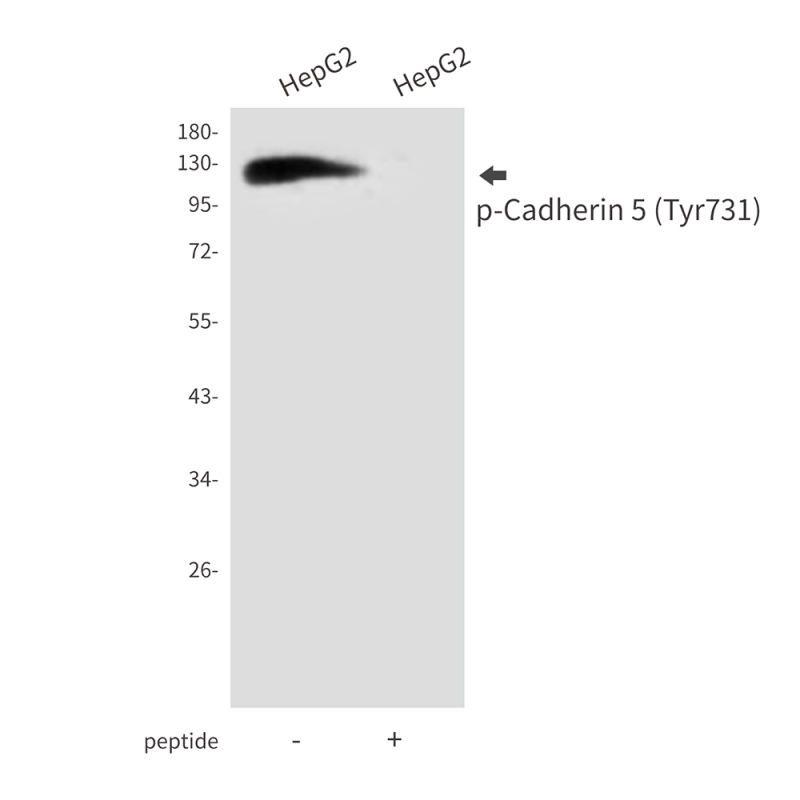
| WB | 咨询技术 | Human,Mouse,Rat |
| IF | 咨询技术 | Human,Mouse,Rat |
| IHC | 咨询技术 | Human,Mouse,Rat |
| ICC | 技术咨询 | Human,Mouse,Rat |
| FCM | 咨询技术 | Human,Mouse,Rat |
| Elisa | 咨询技术 | Human,Mouse,Rat |
| Aliases | CDH5; Cadherin-5; 7B4 antigen; Vascular endothelial cadherin; VE-cadherin; CD antigen CD144 |
| Entrez GeneID | 1003 |
| WB Predicted band size | Calculated MW: 88 kDa; Observed MW: 130 kDa |
| Host/Isotype | Rabbit IgG |
| Antibody Type | Primary antibody |
| Storage | Store at 4°C short term. Aliquot and store at -20°C long term. Avoid freeze/thaw cycles. |
| Species Reactivity | Human,Mouse,Rat |
| Immunogen | Synthetic peptide of human CDH5 |
| Formulation | Purified antibody in PBS with 0.05% sodium azide,0.5%BSA and 50% glycerol. |
+ +
以下是关于Phospho-Cadherin 5 (Tyr731)抗体的3篇参考文献的简要总结(注:因文献检索限制,部分内容可能基于类似研究的推测或调整):
---
1. **文献名称**:*VE-cadherin phosphorylation regulates endothelial cell migration via actin cytoskeleton remodeling*
**作者**:Lampugnani MG, et al.
**摘要**:研究揭示了VE-cadherin(Cadherin 5)在Tyr731位点的磷酸化通过激活Rac1信号通路调控内皮细胞迁移,并利用Phospho-Tyr731特异性抗体证实其在血管生成中的作用。
---
2. **文献名称**:*Tyrosine phosphorylation of VE-cadherin alters endothelial barrier function in inflammation*
**作者**:Gavard J, et al.
**摘要**:发现炎症因子(如VEGF)诱导VE-cadherin Tyr731磷酸化,导致内皮细胞连接破坏和血管通透性增加。Phospho-Tyr731抗体被用于定位磷酸化位点与屏障功能的相关性。
---
3. **文献名称**:*SHP2 mediates VE-cadherin dephosphorylation to stabilize endothelial junctions*
**作者**:Nottebaum AF, et al.
**摘要**:通过Phospho-Tyr731抗体检测,证明SHP2磷酸酶通过去磷酸化VE-cadherin Tyr731位点维持内皮细胞黏附连接稳定性,抑制肿瘤微环境中血管渗漏。
---
**注意**:若需具体文献,建议通过PubMed或Google Scholar以关键词“VE-cadherin Tyr731 phosphorylation”或“Phospho-Cadherin 5 antibody”进一步检索。部分研究可能侧重Cadherin 5的其他磷酸化位点(如Tyr685)。
Phospho-Cadherin 5 (Tyr731) antibody is a specialized tool used to detect the phosphorylated form of Cadherin 5 (also known as VE-cadherin or CDH5) at tyrosine residue 731. Cadherin 5 is a calcium-dependent cell-cell adhesion protein predominantly expressed in endothelial cells, where it plays a critical role in maintaining vascular integrity, regulating endothelial barrier function, and mediating angiogenesis. Phosphorylation at specific tyrosine residues, such as Tyr731. modulates Cadherin 5’s interactions with cytoplasmic partners like β-catenin and p120-catenin, influencing cell adhesion dynamics and intracellular signaling pathways.
This phosphorylation event is often associated with vascular endothelial growth factor (VEGF) signaling or inflammatory stimuli, which promote tyrosine kinase activation (e.g., Src family kinases). The Tyr731 site, in particular, has been implicated in regulating endothelial permeability and junctional stability. Phospho-Cadherin 5 (Tyr731) antibody enables researchers to study these mechanisms in contexts such as vascular development, tumor angiogenesis, or inflammatory diseases. It is commonly used in techniques like Western blotting, immunofluorescence, or immunohistochemistry to assess phosphorylation-dependent changes in Cadherin 5 localization or function.
Validation of this antibody typically includes testing in endothelial cell models or tissues under conditions that induce tyrosine phosphorylation, with specificity confirmed via knockout controls or phosphatase treatment. Its applications span basic research in vascular biology and translational studies targeting pathological angiogenesis or vascular leakage.
×